1993 PONTIAC GRAND-AM brakes
[x] Cancel search: brakesPage 133 of 306
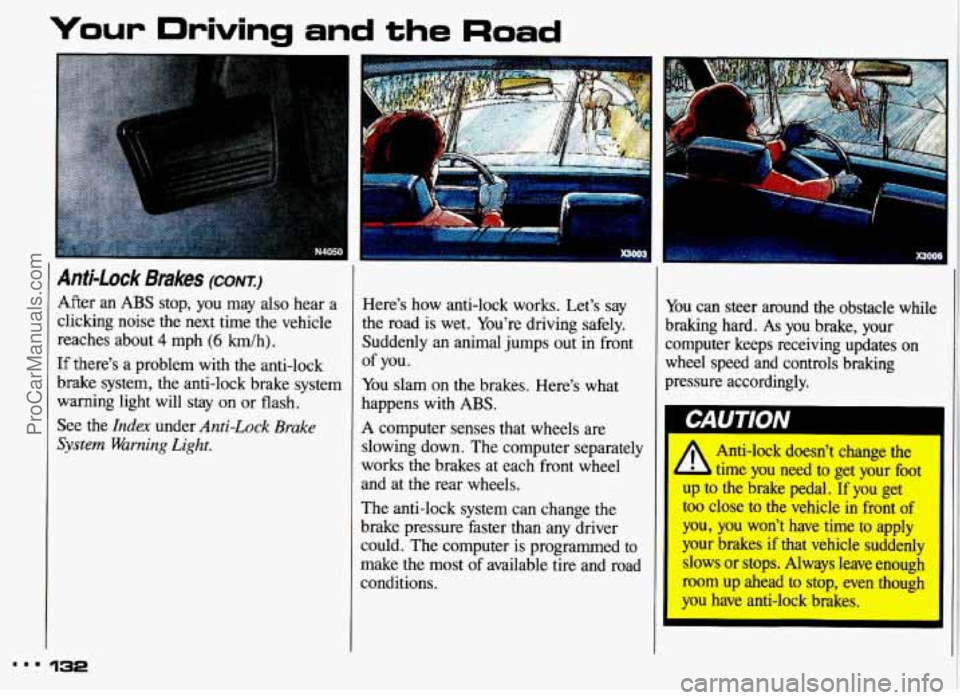
...
Your Driving and the Road
Anti-Lock Brakes (CONT.)
After an ABS stop, you may also hear a
clicking noise the next time the vehicle
reaches about
4 mph (6 km/h).
If there’s a problem with the anti-lock
brake system, the anti-lock brake system
warning light will stay
on or flash.
See the
Index under Anti-Lock Brake
System Warning Light.
132
Here’s how anti-lock works. Let’s say
the road is wet. You’re driving safely.
Suddenly an animal jumps out in front
You slam on the brakes. Here’s what
happens with ABS.
A computer senses that wheels are
slowing down. The computer separately
works the brakes at each front wheel
and at the rear wheels.
The anti-lock system can change the
of you.
brake pressure faster than any driver
could. The computer
is programmed to
make the most
of available tire and road
conditions. You
can steer around the obstacle while
braking hard.
As you brake, your
computer keeps receiving updates on
wheel speed and controls braking
pressure accordingly.
Anti-lock doesn’t change the
time you need
to get your foot
the brake pedal. If you get
too close to the vehicle in front
of
I you, you won’t have time to apply
your brakes
if that vehicle suddenly
slows or stops. Always leave enough
room up ahead to stop, even though
you have anti-lock brakes.
ProCarManuals.com
Page 134 of 306

To Use Anti-Lock:
Don’t pump the brakes. Just hold the
brake pedal down and let anti-lock work
for
you. You may hear a clicking noise
as you accelerate after a hard stop.
Disc Brake Wear Indicators
Your Pontiac has front disc brakes and
rear drum brakes. Disc brake pads have
built-in wear indicators that make a
high-pitched warning sound when the
brake pads are worn and new pads are
needed. The sound may come and go or
be heard all the time your vehicle is
moving (except when you are pushing
on the brake pedal firmly).
A
The brake wear warning
sound means that sooner
or
later your brakes won’t work well.
That could lead to an accident.
When you hear the brake wear
warning sound, have your vehicle
serviced.
133
ProCarManuals.com
Page 135 of 306
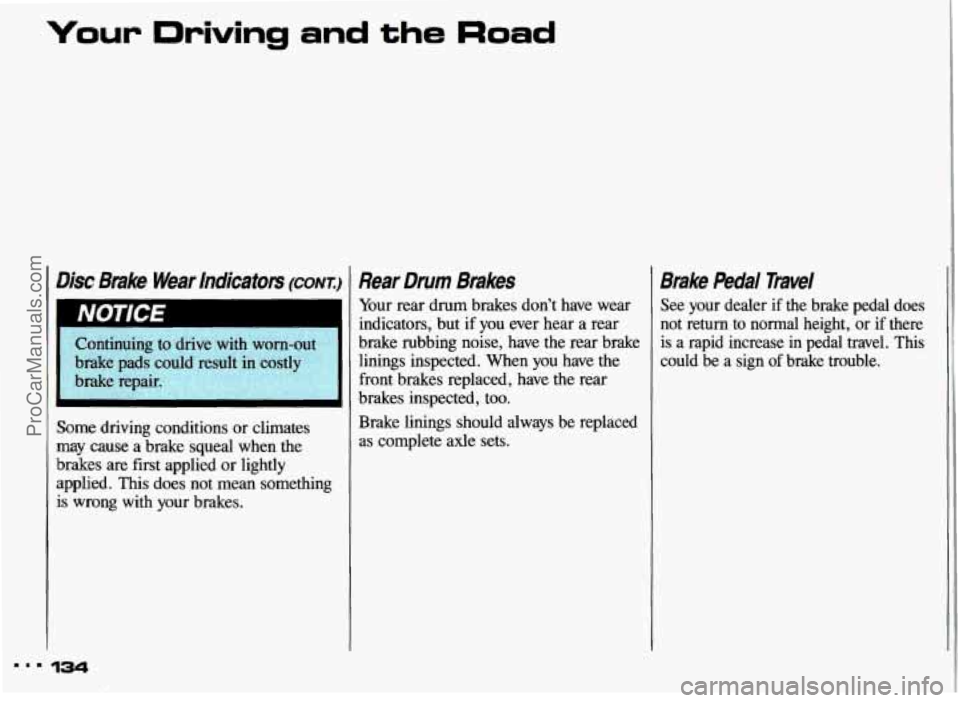
'Your Driving and the Road
Disc Brake Wear Indicators (CONTJ
I
Continuing to drive with worn-out
brake pads could res
: brake repair. P". I
Some driving conditions or climates
may cause a brake squeal when the
brakes are fmt applied or lightly
applied. This does not mean something
is wrong with your brakes.
Rear Drum Brakes
Your rear drum brakes don't have wear
indicators, but if you ever hear a rear
brake rubbing noise, have the rear brake
linings inspected. When you have the
front brakes replaced, have the rear
brakes inspected, too.
Brake linings should always be replaced
as complete axle sets.
Brake Pedal Travel
See your dealer if the brake pedal does
not return to normal height, or if there
is a rapid increase in pedal travel. This
could be
a sign of brake trouble.
ProCarManuals.com
Page 136 of 306
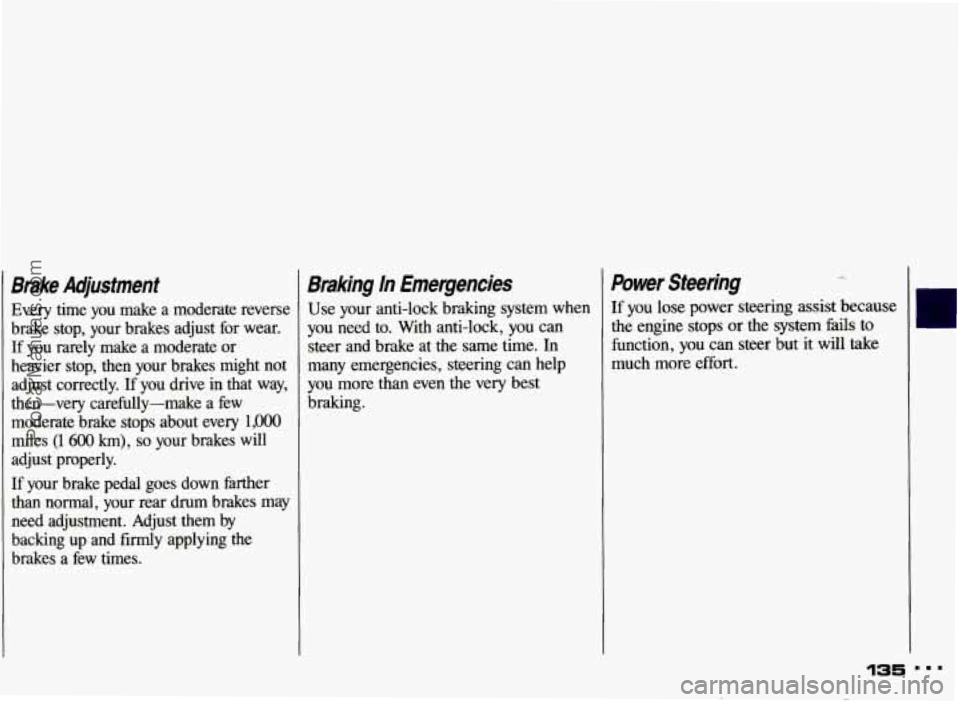
Brake Aflustment
Every time you make a moderate reverse
brake stop, your brakes adjust for wear.
If you rarely make a moderate or
heavier stop, then your brakes might not
adjust correctly. If you drive
in that way,
then-very carefully-make a few
moderate brake stops about every
1,OOO
miles (1 600 km), so your brakes will
adjust properly.
If your brake pedal goes down farther
than
normal, your rear drum brakes may
need adjustment. Adjust them by
backing up and
firmly applying the
brakes a few times.
Braking In Emergencies
Use your anti-lock braking system when
you need to. With anti-lock, you can
steer and brake at the same time. In
many emergencies, steering can help
you more than even the very best
braking.
Power Steering -
If you lose power steering assist because
the engine stops or the system fails to
function, you can steer but it will
take
much more effort.
135
ProCarManuals.com
Page 138 of 306
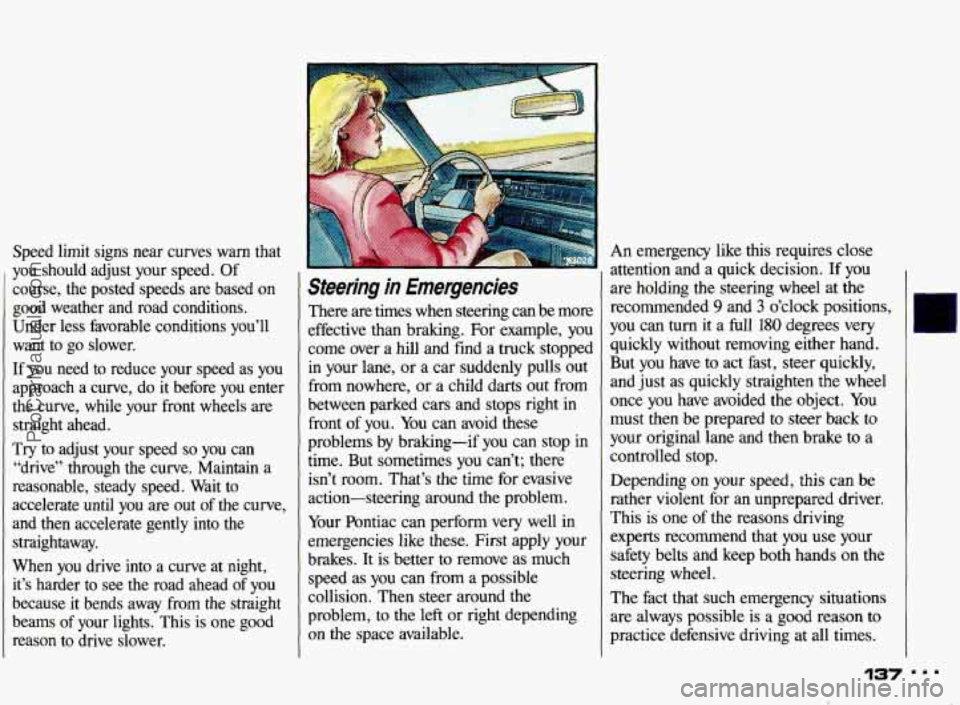
Speed limit signs near curves warn that
you should adjust your speed. Of
course, the posted speeds are based
on
good weather and road conditions.
Under less favorable conditions you’ll
want to go slower.
If you need to reduce your speed as you
approach a curve, do it before you enter
the curve, while your front wheels are
straight ahead.
Try to adjust your speed
so you can
“drive” through the curve. Maintain a
reasonable, steady speed. Wait to
accelerate until
you are out of the curve,
and then accelerate gently into the
straightaway.
When
you drive into a curve at night,
it’s harder to see the road ahead of you
because it bends away from the straight
beams of your lights. This is one good
reason to drive slower.
Steering in Emergencies
There are times when steering can be more
effective than braking. For example, you
come over a hill and find a truck stopped
in your lane, or a car suddenly pulls out
from nowhere, or a child darts out from
between parked cars and stops right in
front of you.
You can avoid these
problems by braking-if
you can stop in
time. But sometimes you can’t; there
isn’t
room. That’s the time for evasive
action-steering around the problem.
Your Pontiac can perform very well in
emergencies like these. First apply your
brakes. It is better to remove as much
speed as you can from a possible
collision. Then steer around the
problem, to the left or right depending
on the space available. An emergency like this requires
close
attention and
a quick decision. If you
are holding the steering wheel at the
recommended
9 and 3 o’clock positions,
you can turn it a
full 180 degrees very
quickly without removing either hand.
But
you have to act fast, steer quickly,
and just as quickly straighten the wheel
once
you have avoided the object. You
must then be prepared to steer back to
your original lane and then brake to a
controlled stop.
Depending on your speed, this can
be
rather violent for an unprepared driver.
This is one of the reasons driving
experts recommend that
you use your
safety belts and keep both hands on the
steering wheel.
The fact that such emergency situations
are always possible is a good reason to
practice defensive driving at all times.
ProCarManuals.com
Page 141 of 306
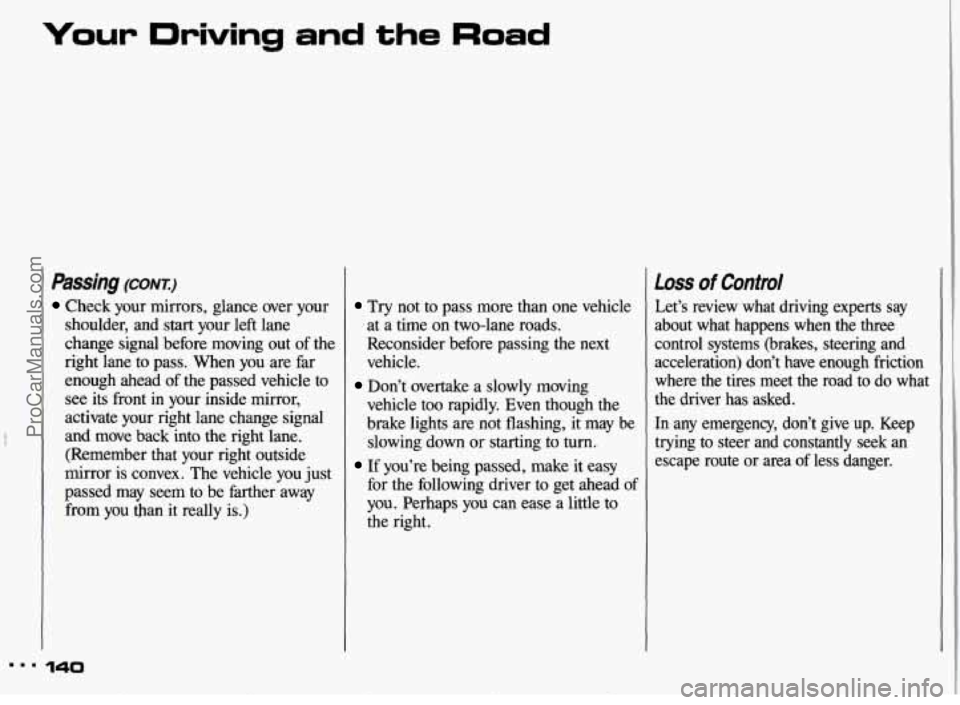
Your Driving and the Road
Passing (CONT.)
Check your mirrors, glance over your
shoulder, and
start your left lane
change signal before moving out of the
right lane to pass. When you are far
enough ahead of the passed vehicle to
see its front in your inside mirror,
activate your right lane change signal
and move back into the right lane.
(Remember that your right outside
mirror
is convex. The vehicle you just
passed may seem to be farther away
from
you than it really is.)
140
Try not to pass more than one vehicle
at a time on two-lane roads.
Reconsider before passing the next
vehicle.
vehicle too rapidly. Even though the
brake lights are not flashing, it may be
slowing down
or starting to turn.
If you’re being passed, make it easy
for the following driver to get ahead of
you. Perhaps you can ease a little to
the right.
Don’t overtake a slowly moving
Loss of Control
Let’s review what driving experts say
about what happens when the three
control systems (brakes, steering and
acceleration) don’t have enough friction
where the tires meet the road to do what
the driver has asked.
In any emergency, don’t give up. Keep
trying to steer and constantly seek an
escape route or area
of less danger.
ProCarManuals.com
Page 146 of 306
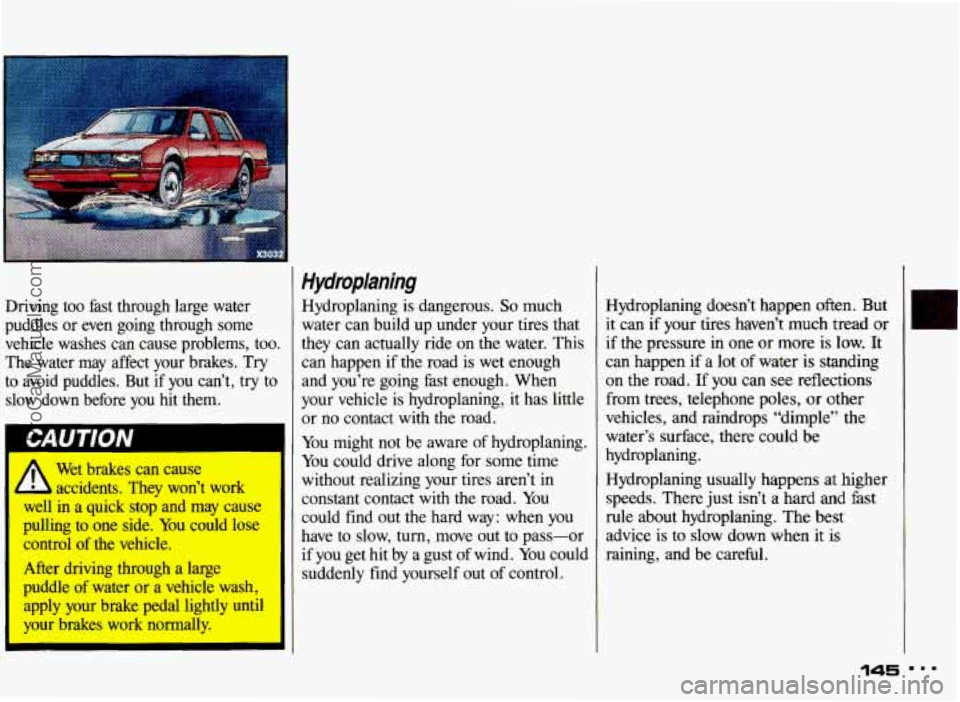
Driving too fast through Parge water
puddles or even going through some
vehicle washes can cause problems, toc The water may affect your brakes.
Try
to avoid puddles. But if you can’t, try to
slow down before you hit them.
t.
I
1 CAUTION I
Wet brakes can cause
accidents. They won’t work
dl in a quick stop and may cause
pulling to one side. You could lose
control of the vehicle.
After driving through a large
puddle of water or a vehicle wash,
apply your brake pedal lightly until
your brakes work normally.
Hydroplaning
Hydroplaning is dangerous. So much
water can build up under your tires that
they can actually ride on the water. This
can happen if the road is wet enough
and you’re going fast enough. When
your vehicle is hydroplaning, it has little
or no contact with the road.
You might not be aware
of hydroplaning.
You could drive along for some time
without realizing your tires aren’t in
constant contact with the road. You
could find out the hard way: when you
have to slow, turn, move out to pass-or
if you get hit by a gust
of wind. You could
suddenly find yourself out of control. Hydroplaning doesn’t
happen often. But
it can if your tires haven’t much tread
or
if the pressure in one or more is low. It
can happen if a lot of water is standing
on the road. If you can
see reflections
from trees, telephone poles, or other
vehicles, and raindrops “dimple” the
water’s surface, there could
be
hydroplaning.
Hydroplaning usually happens at higher
speeds. There just isn’t
a hard and fast
rule about hydroplaning. The best
advice is to slow down when it
is
raining, and be careful.
145 ’
ProCarManuals.com
Page 153 of 306

your urwlng and the Road
Highway Hypnosis (CONI)
Keep your eyes moving. Scan the road
ahead and to the sides. Check your
rearview mirrors frequently and your
instruments from time to time. This
can help you avoid a fixed stare.
Wear good sunglasses in bright light.
Glare can cause drowsiness. But don’t
wear sunglasses at night. They will
drastically reduce your overall vision
at the very time you need all the
seeing power you have.
If you get sleepy, pull off the road into
a rest, service, or parking area and
take a nap, get some exercise, or both.
For safety, treat drowsiness on the
highway as an emergency.
As in any driving situation, keep pace
with traffic and allow adequate
following distances.
I CAUTION
d
Hill and Mountain Roads
Driving on steep hills or mountains is
different from driving in flat or rolling
terrain. If
you drive regularly in steep
country, or
if you’re planning to visit
there, here are
some tips that can make
your trips safer and more enjoyable.
Keep your vehicle in good shape.
Check all fluid levels and also the
brakes, tires, cooling system and
transaxle. These parts can work hard
on mountain roads.
Know how to go down hills. The most
important thing to know
is this: let
your engine do some of the slowing
down. Don’t make your brakes
do it
all. Shift to a lower gear when
you go
down a steep or long hill. That way,
you will slow down without excessive
use of your brakes.
A
If you don’t shift down, your
brakes could get
so hot that
they wouldn’t work well.
You
would then have poor braking or
even none going down a hill. You
could crash. Shift down to let your
engine assist your brakes on
a
steep downhill slope.
ProCarManuals.com